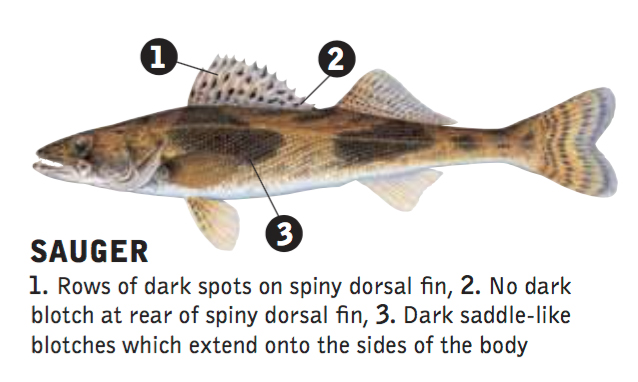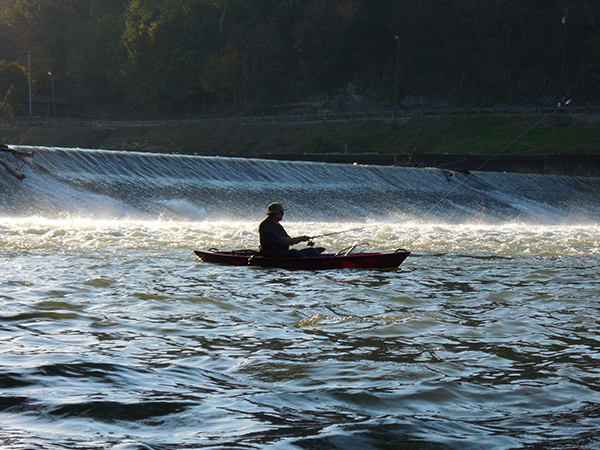Editor’s note: This is the ninth article in a series about Kentucky’s gamefish species.
The sauger (Sander canadense) is a river fish that isn’t as widely distributed or abundant in Kentucky as it once was, due primarily to the blocking of spawning routes.
Since sauger prefer current to slack water, high-rise dams are a hindrance to migration. Sauger do not thrive in lake environments. Populations tend to fluctuate dramatically.
The only place in Kentucky where sauger are now stocked is the Kentucky River. Pools 2 through 6 and 8 through 13 are stocked annually with 1 1/2-inch fingerling sauger, reared at the Peter W. Pfeiffer Fish Hatchery near Frankfort.
Size and Coloration
The sauger is a member of the family Percidae, the perches and darters.
This slender, toothy fish that closely resembles a walleye, and is often misidentified by anglers since both fish frequently live in the same waters.
The sauger’s back is dark to yellowish-green, with lighter sides and a silver to whitish belly. The back is crossed with blotch-like saddle bands. There are rows of dark spots on its spiny dorsal fin.
Adult sauger can grow to 30 inches, weighing about 8 pounds, but an 18-inch fish, that weighs about 3 to 4 pounds, is considered a trophy.
Distribution in Kentucky
Sauger are present in all of Kentucky’s river drainages, but most abundant in the Barren, Cumberland, Green, Kentucky, Nolin, Ohio and Tennessee rivers.
Today, sauger are present in three major reservoirs, Lake Barkley, Lake Cumberland and Kentucky Lake.
This fish was first described in the scientific literature in 1820 by French naturalist Constantine Samuel Rafinesque, who collected a specimen from the Ohio River and named it Perca salmonea. His description appears to be a compilation of sauger and walleye characteristics. He made no distinction between the two species.
Food Habits
Sauger travel in schools and feed primarily on shad, minnows and crayfish.
Fishing Tips
Sauger are cool-water fish that begin their spawning run in February when water temperatures are in the upper 40s or low 50s.
Some of the best fishing during the late winter and early spring is in tailwaters, below dams, where sauger congregate around nearby creek mouths, rocky banks and sandbars.
Tailwaters also offer good fishing in the fall, as temperatures cool down and sauger move closer to dams from deep holes and the outside bends of river channels.
Sauger live and feed near the bottom, fostering the misconceptions that sauger live in deep water and that specialized fishing techniques are needed to catch them. This is not the case at all.
Sauger can be caught on spinning tackle casting jigs into water just a few feet deep. They are easy, once you figure out their subtle bite.
In lakes, a productive fishing method is trolling deep-diving crankbaits along main lake and secondary channel breaks.
Creel Limits
The statewide daily creel limit is six fish, with a 14-inch minimum size limit, but some waters, where both sauger and walleye are present, may have special regulations.
Consult the Kentucky Fishing and Boating Guide for more information.

"fish" - Google News
September 04, 2020 at 11:42AM
https://ift.tt/3gYAh6o
Art Lander's Outdoors: Primarily a river fish, sauger are also present in Kentucky's Lakes and tailwaters - User-generated content
"fish" - Google News
https://ift.tt/35JkYuc
https://ift.tt/3feFffJ
Bagikan Berita Ini

















0 Response to "Art Lander's Outdoors: Primarily a river fish, sauger are also present in Kentucky's Lakes and tailwaters - User-generated content"
Post a Comment